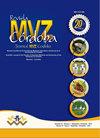Differential effect of rice husk and xylan on feruloyl esterase activity in Penicillium rubens.
IF 0.3
4区 农林科学
Q4 AGRICULTURE, DAIRY & ANIMAL SCIENCE
引用次数: 0
Abstract
Objective. Analyzed the effect of xylan and rice husk as sole sources of carbon on the FAE activity and expression of faeA and faeB genes of Penicillium rubens (Wisconsin 54-1255), in submerged fermentation. Materials and methods. The fermentations were carried out for 24, 48, and 72 h (28°C/250 rpm), in flasks with a modified Sakamoto medium. FAE activity was determined using the synthetic substrate Ethyl 4-hydroxy-3-methoxycinnamate. The transcription of faeA and faeB was analyzed by RT-PCR. The PCR products were resolved by electrophoresis and analyzed by densitometry. Results. The analysis of gene expression showed that the use of xylan had a positive effect on the expression of both genes. The highest transcriptional activity of both faeA and faeB was detected at 48 h. On the other hand, rice husk showed negative results. The data obtained when the FAE activity was determined, supported the results observed in the gene expression analysis. Conclusion. Different from xylan the rice husk did not demonstrate an inducer effect on the feruloyl esterase activity in P. rubens.稻壳和木聚糖对红青霉阿魏酰酯酶活性的差异影响。
客观的分析了木聚糖和稻壳作为唯一碳源对德国青霉菌(Wisconsin 54-1255)深层发酵中FAE活性和faeA和faeB基因表达的影响。材料和方法。发酵在装有改良Sakamoto培养基的烧瓶中进行24、48和72小时(28°C/250rpm)。使用合成底物4-羟基-3-甲氧基肉桂酸乙酯测定FAE活性。用RT-PCR方法分析faeA和faeB的转录。PCR产物通过电泳进行解析,并通过密度计进行分析。后果基因表达分析表明,木聚糖的使用对两种基因的表达都有积极影响。faeA和faeB的最高转录活性在48小时时检测到。另一方面,稻壳显示出阴性结果。当测定FAE活性时获得的数据支持在基因表达分析中观察到的结果。结论与木聚糖不同的是,稻壳对红曲霉阿魏酰酯酶活性没有诱导作用。
本文章由计算机程序翻译,如有差异,请以英文原文为准。
求助全文
约1分钟内获得全文
求助全文
来源期刊

Revista Mvz Cordoba
农林科学-奶制品与动物科学
CiteScore
0.70
自引率
0.00%
发文量
41
审稿时长
6-12 weeks
期刊介绍:
The Journal MVZ Córdoba is an open access international scientific journal financed and edited by the University of Córdoba (Colombia). The journal publishes quarterly, continuously in PDF, XML, Epub, original articles, literature reviews, brief communications and clinical cases, peer-reviewed (double-blind) in Spanish and English, which are related to the agricultural and veterinary sciences. The journal is directed to natural and legal persons of veterinary medicine, animal husbandry, public health, epidemiology, aquaculture, biology, basic biomedical sciences and biotechnology and constitutes a space for academic and scientific discussion around the work of professionals in Veterinary Medicine and Zootechnics. Four-monthly publication.
"The Journal MVZ Córdoba supports the policies for registration of clinical trials of the World Health Organization (WHO) and the International Committee of Medical Journal Editors (ICMJE), since it recognizes the importance of these initiatives for international registration and dissemination. of information about clinical studies, in open access. As a result, since 2007, the journal MVZ Córdoba only publishes clinical research articles that have received an identification number in one of the Clinical Trial Registries validated by the criteria established by WHO and ICMJE, whose addresses are available in the ICMJE website. The identification number is recorded at the end of the summary. "
 求助内容:
求助内容: 应助结果提醒方式:
应助结果提醒方式:


